engine coolant Ram 1500 2020 User Guide
[x] Cancel search | Manufacturer: RAM, Model Year: 2020, Model line: 1500, Model: Ram 1500 2020Pages: 674, PDF Size: 32.69 MB
Page 491 of 674
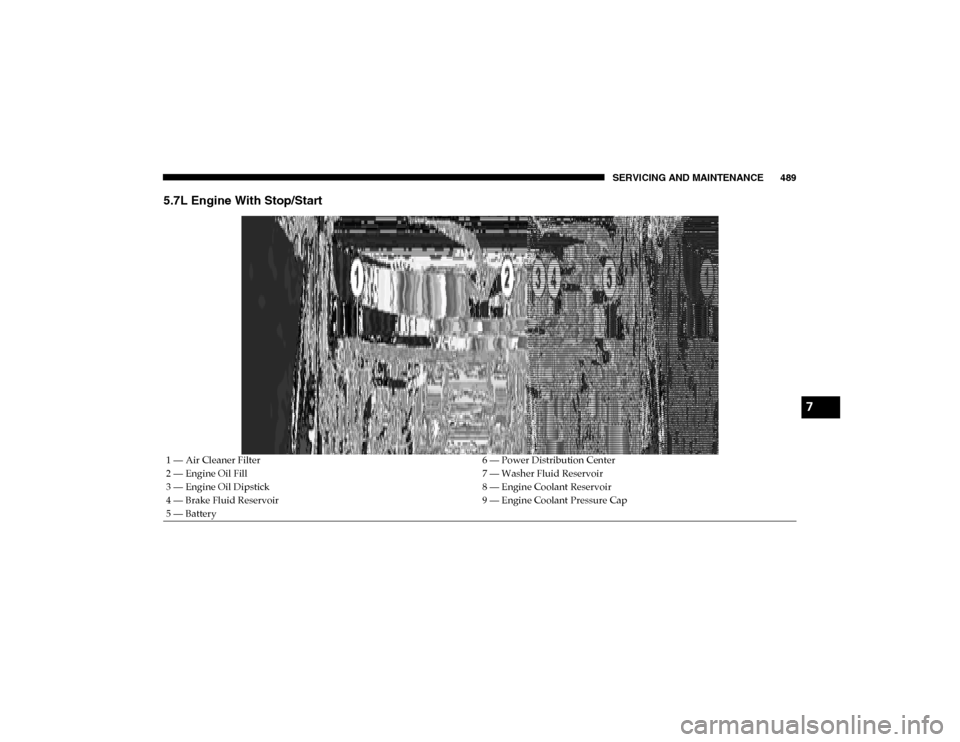
SERVICING AND MAINTENANCE 489
5.7L Engine With Stop/Start
1 — Air Cleaner Filter6 — Power Distribution Center
2 — Engine Oil Fill 7 — Washer Fluid Reservoir
3 — Engine Oil Dipstick 8 — Engine Coolant Reservoir
4 — Brake Fluid Reservoir 9 — Engine Coolant Pressure Cap
5 — Battery
7
2020_DT_1500_OM_US.book Page 489
Page 508 of 674
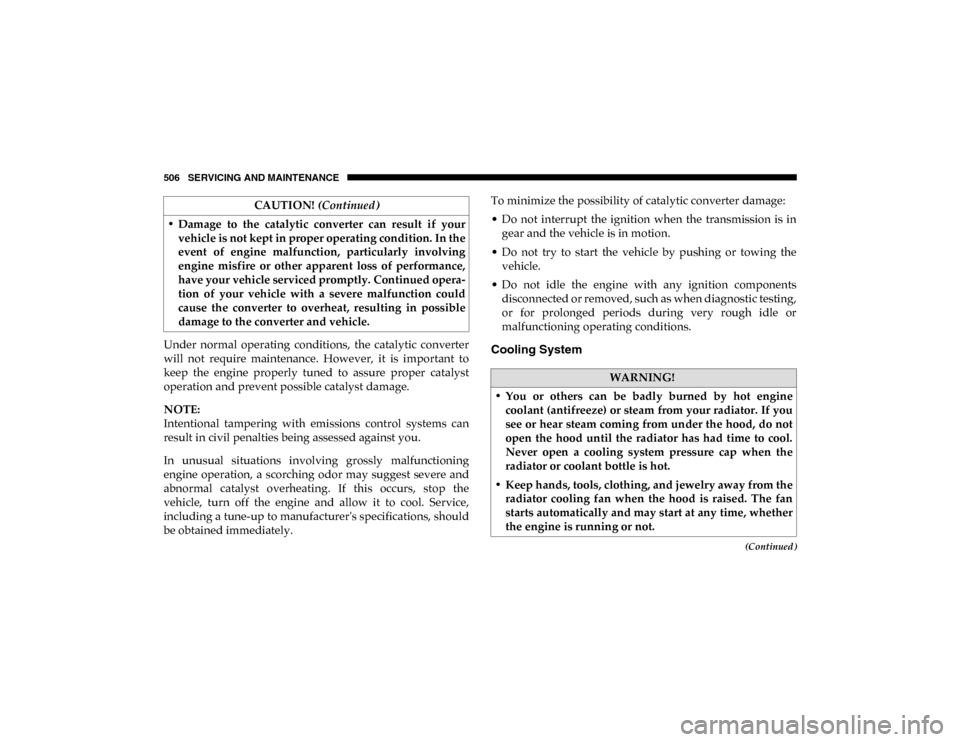
506 SERVICING AND MAINTENANCE
(Continued)
Under normal operating conditions, the catalytic converter
will not require maintenance. However, it is important to
keep the engine properly tuned to assure proper catalyst
operation and prevent possible catalyst damage.
NOTE:
Intentional tampering with emissions control systems can
result in civil penalties being assessed against you.
In unusual situations involving grossly malfunctioning
engine operation, a scorching odor may suggest severe and
abnormal catalyst overheating. If this occurs, stop the
vehicle, turn off the engine and allow it to cool. Service,
including a tune-up to manufacturer's specifications, should
be obtained immediately.To minimize the possibility of catalytic converter damage:
• Do not interrupt the ignition when the transmission is in
gear and the vehicle is in motion.
• Do not try to start the vehicle by pushing or towing the vehicle.
• Do not idle the engine with any ignition components disconnected or removed, such as when diagnostic testing,
or for prolonged periods during very rough idle or
malfunctioning operating conditions.Cooling System
• Damage to the catalytic converter can result if yourvehicle is not kept in proper operating condition. In the
event of engine malfunction, particularly involving
engine misfire or other apparent loss of performance,
have your vehicle serviced promptly. Continued opera -
tion of your vehicle with a severe malfunction could
cause the converter to overheat, resulting in possible
damage to the converter and vehicle. CAUTION!
(Continued)
WARNING!
• You or others can be badly burned by hot engine coolant (antifreeze) or steam from your radiator. If you
see or hear steam coming from under the hood, do not
open the hood until the radiator has had time to cool.
Never open a cooling system pressure cap when the
radiator or coolant bottle is hot.
• Keep hands, tools, clothing, and jewelry away from the radiator cooling fan when the hood is raised. The fan
starts automatically and may start at any time, whether
the engine is running or not.
2020_DT_1500_OM_US.book Page 506
Page 509 of 674
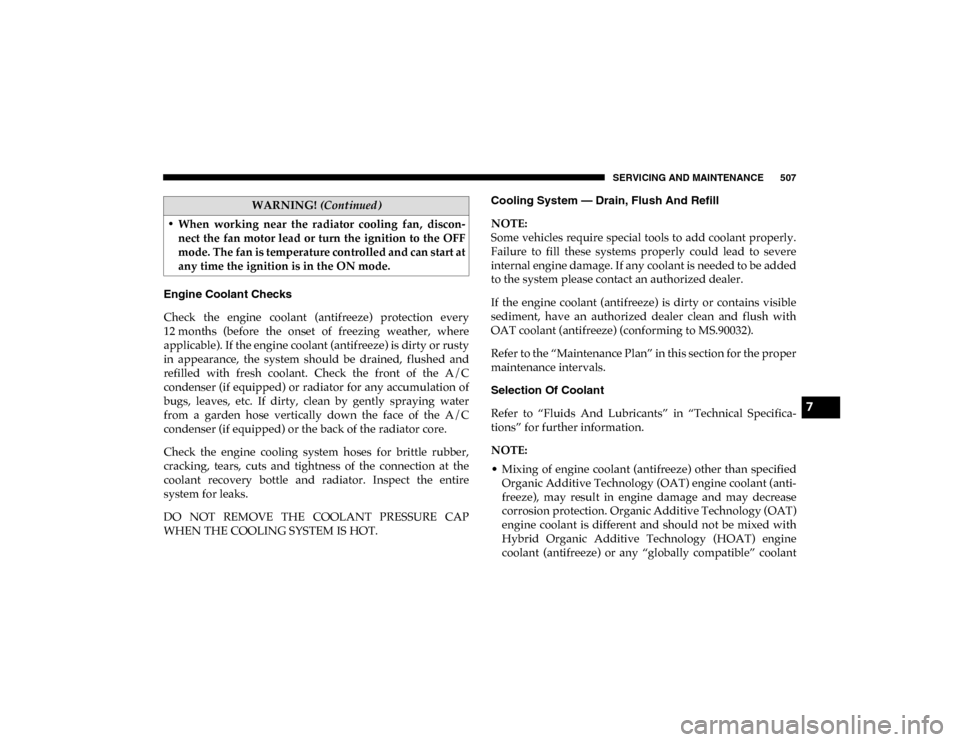
SERVICING AND MAINTENANCE 507
Engine Coolant Checks
Check the engine coolant (antifreeze) protection every
12 months (before the onset of freezing weather, where
applicable). If the engine coolant (antifreeze) is dirty or rusty
in appearance, the system should be drained, flushed and
refilled with fresh coolant. Check the front of the A/C
condenser (if equipped) or radiator for any accumulation of
bugs, leaves, etc. If dirty, clean by gently spraying water
from a garden hose vertically down the face of the A/C
condenser (if equipped) or the back of the radiator core.
Check the engine cooling system hoses for brittle rubber,
cracking, tears, cuts and tightness of the connection at the
coolant recovery bottle and radiator. Inspect the entire
system for leaks.
DO NOT REMOVE THE COOLANT PRESSURE CAP
WHEN THE COOLING SYSTEM IS HOT. Cooling System — Drain, Flush And Refill
NOTE:
Some vehicles require special tools to add coolant properly.
Failure to fill these systems properly could lead to severe
internal engine damage. If any coolant is needed to be added
to the system please contact an authorized dealer.
If the engine coolant (antifreeze) is dirty or contains visible
sediment, have an authorized dealer clean and flush with
OAT coolant (antifreeze) (conforming to MS.90032).
Refer to the “Maintenance Plan” in this section for the proper
maintenance intervals.
Selection Of Coolant
Refer to “Fluids And Lubricants” in “Technical Specifica
-
tions” for further information.
NOTE:
• Mixing of engine coolant (antifreeze) other than specified Organic Additive Technology (OAT) engine coolant (anti -
freeze), may result in engine damage and may decrease
corrosion protection. Organic Additive Technology (OAT)
engine coolant is different and should not be mixed with
Hybrid Organic Additive Technology (HOAT) engine
coolant (antifreeze) or any “globally compatible” coolant
• When working near the radiator cooling fan, discon
-
nect the fan motor lead or turn the ignition to the OFF
mode. The fan is temperature controlled and can start at
any time the ignition is in the ON mode.
WARNING! (Continued)
7
2020_DT_1500_OM_US.book Page 507
Page 510 of 674

508 SERVICING AND MAINTENANCE
(antifreeze). If a non-OAT engine coolant (antifreeze) is
introduced into the cooling system in an emergency, the
cooling system will need to be drained, flushed, and
refilled with fresh OAT coolant (conforming to MS.90032),
by an authorized dealer as soon as possible.
• Do not use water alone or alcohol-based engine coolant (antifreeze) products. Do not use additional rust inhibitors
or antirust products, as they may not be compatible with
the radiator engine coolant and may plug the radiator.
• This vehicle has not been designed for use with propylene glycol-based engine coolant (antifreeze). Use of propylene
glycol-based engine coolant (antifreeze) is not recom -
mended.
• Some vehicles require special tools to add coolant prop -
erly. Failure to fill these systems properly could lead to
severe internal engine damage. If any coolant is needed to
be added to the system please contact an authorized
dealer.
Adding Coolant
Your vehicle has been built with an improved engine coolant
(OAT coolant conforming to MS.90032) that allows extended
maintenance intervals. This engine coolant (antifreeze) can
be used up to 10 years or 150,000 miles (240,000 km) before
replacement. To prevent reducing this extended mainte -nance period, it is important that you use the same engine
coolant (OAT coolant conforming to MS.90032) throughout
the life of your vehicle.
Please review these recommendations for using Organic
Additive Technology (OAT) engine coolant (antifreeze) that
meets the requirements of FCA Material Standard MS.90032.
When adding engine coolant (antifreeze):
• We recommend using Mopar® Antifreeze/Coolant 10 Year/
150,000 Mile (240,000 km) Formula OAT (Organic Additive
Technology) that meets the requirements of FCA Material
Standard MS.90032.
• Mix a minimum solution of 50% OAT engine coolant that meets the requirements of FCA Material Standard
MS.90032 and distilled water. Use higher concentrations
(not to exceed 70%) if temperatures below −34°F (−37°C)
are anticipated. Please contact an authorized dealer for
assistance.
• Use only high purity water such as distilled or deionized water when mixing the water/engine coolant (antifreeze)
solution. The use of lower quality water will reduce the
amount of corrosion protection in the engine cooling
system.
2020_DT_1500_OM_US.book Page 508
Page 511 of 674
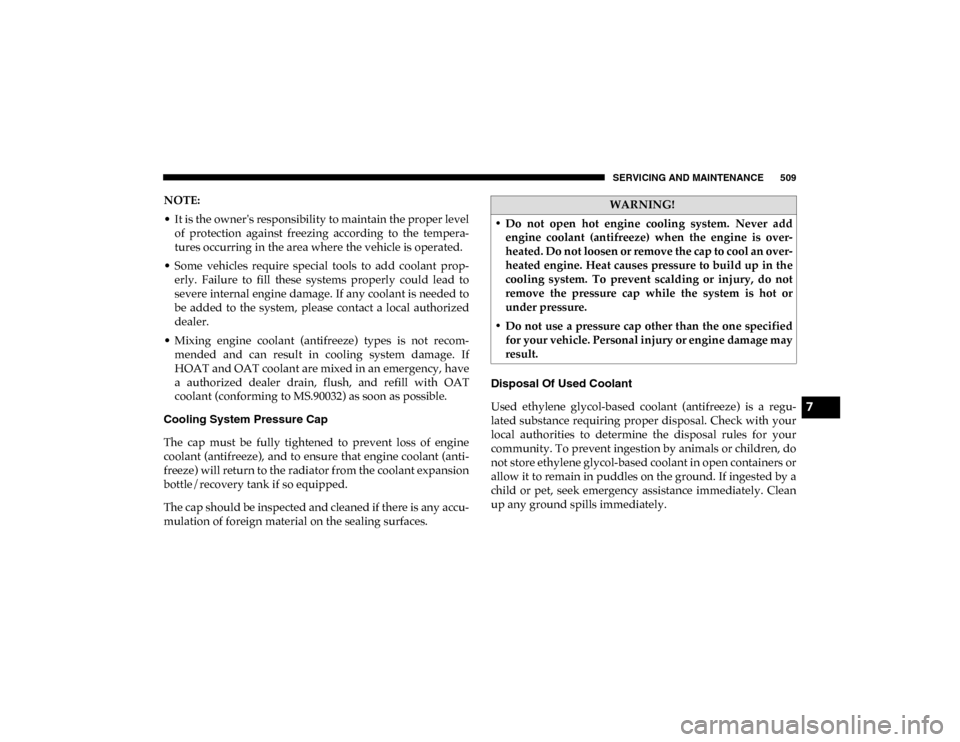
SERVICING AND MAINTENANCE 509
NOTE:
• It is the owner's responsibility to maintain the proper levelof protection against freezing according to the tempera -
tures occurring in the area where the vehicle is operated.
• Some vehicles require special tools to add coolant prop -
erly. Failure to fill these systems properly could lead to
severe internal engine damage. If any coolant is needed to
be added to the system, please contact a local authorized
dealer.
• Mixing engine coolant (antifreeze) types is not recom -
mended and can result in cooling system damage. If
HOAT and OAT coolant are mixed in an emergency, have
a authorized dealer drain, flush, and refill with OAT
coolant (conforming to MS.90032) as soon as possible.
Cooling System Pressure Cap
The cap must be fully tightened to prevent loss of engine
coolant (antifreeze), and to ensure that engine coolant (anti -
freeze) will return to the radiator from the coolant expansion
bottle/recovery tank if so equipped.
The cap should be inspected and cleaned if there is any accu-
mulation of foreign material on the sealing surfaces. Disposal Of Used Coolant
Used ethylene glycol-based coolant (antifreeze) is a regu-
lated substance requiring proper disposal. Check with your
local authorities to determine the disposal rules for your
community. To prevent ingestion by animals or children, do
not store ethylene glycol-based coolant in open containers or
allow it to remain in puddles on the ground. If ingested by a
child or pet, seek emergency assistance immediately. Clean
up any ground spills immediately.WARNING!
• Do not open hot engine cooling system. Never add engine coolant (antifreeze) when the engine is over -
heated. Do not loosen or remove the cap to cool an over -
heated engine. Heat causes pressure to build up in the
cooling system. To prevent scalding or injury, do not
remove the pressure cap while the system is hot or
under pressure.
• Do not use a pressure cap other than the one specified for your vehicle. Personal injury or engine damage may
result.
7
2020_DT_1500_OM_US.book Page 509
Page 512 of 674
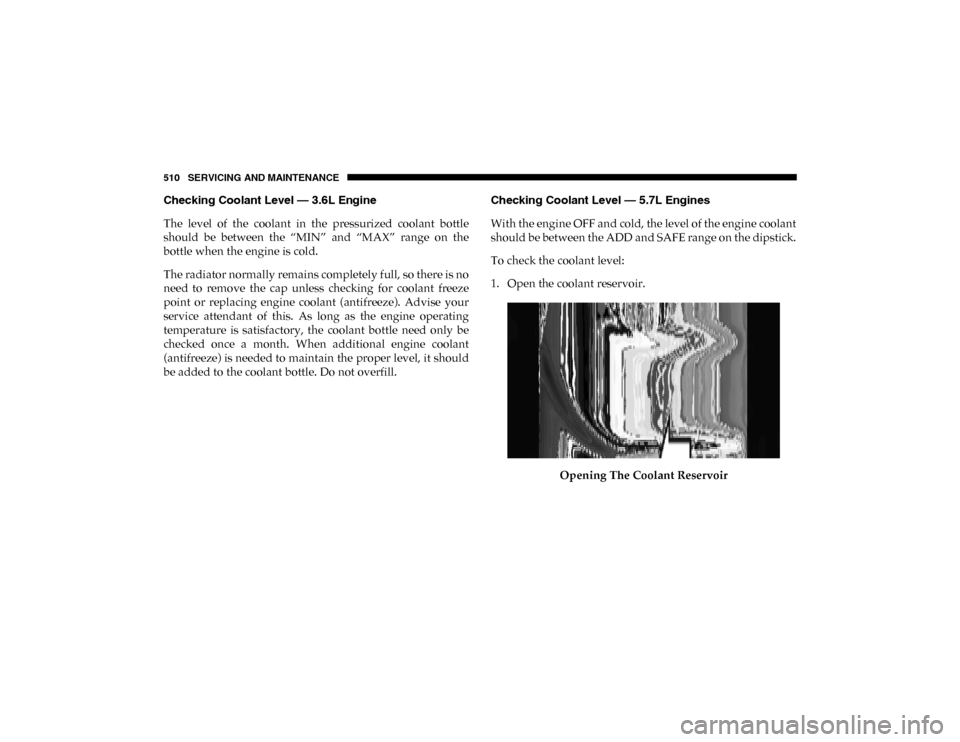
510 SERVICING AND MAINTENANCE
Checking Coolant Level — 3.6L Engine
The level of the coolant in the pressurized coolant bottle
should be between the “MIN” and “MAX” range on the
bottle when the engine is cold.
The radiator normally remains completely full, so there is no
need to remove the cap unless checking for coolant freeze
point or replacing engine coolant (antifreeze). Advise your
service attendant of this. As long as the engine operating
temperature is satisfactory, the coolant bottle need only be
checked once a month. When additional engine coolant
(antifreeze) is needed to maintain the proper level, it should
be added to the coolant bottle. Do not overfill.Checking Coolant Level — 5.7L Engines
With the engine OFF and cold, the level of the engine coolant
should be between the ADD and SAFE range on the dipstick.
To check the coolant level:
1. Open the coolant reservoir.
Opening The Coolant Reservoir
2020_DT_1500_OM_US.book Page 510
Page 513 of 674
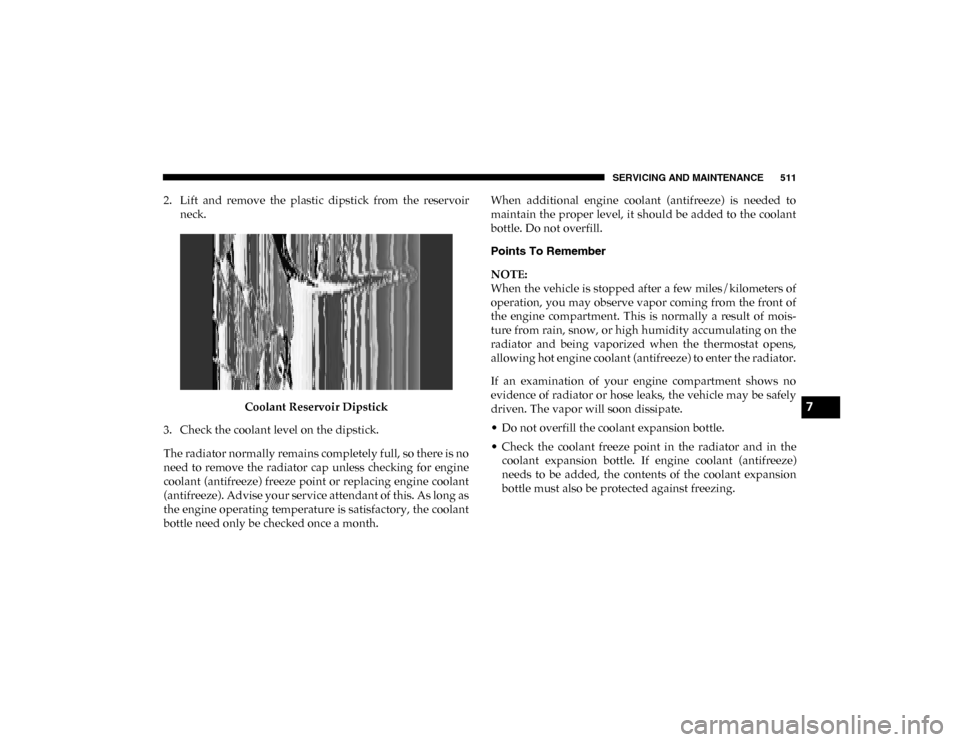
SERVICING AND MAINTENANCE 511
2. Lift and remove the plastic dipstick from the reservoirneck.
Coolant Reservoir Dipstick
3. Check the coolant level on the dipstick.
The radiator normally remains completely full, so there is no
need to remove the radiator cap unless checking for engine
coolant (antifreeze) freeze point or replacing engine coolant
(antifreeze). Advise your service attendant of this. As long as
the engine operating temperature is satisfactory, the coolant
bottle need only be checked once a month. When additional engine coolant (antifreeze) is needed to
maintain the proper level, it should be added to the coolant
bottle. Do not overfill.
Points To Remember
NOTE:
When the vehicle is stopped after a few miles/kilometers of
operation, you may observe vapor coming from the front of
the engine compartment. This is normally a result of mois
-
ture from rain, snow, or high humidity accumulating on the
radiator and being vaporized when the thermostat opens,
allowing hot engine coolant (antifreeze) to enter the radiator.
If an examination of your engine compartment shows no
evidence of radiator or hose leaks, the vehicle may be safely
driven. The vapor will soon dissipate.
• Do not overfill the coolant expansion bottle.
• Check the coolant freeze point in the radiator and in the coolant expansion bottle. If engine coolant (antifreeze)
needs to be added, the contents of the coolant expansion
bottle must also be protected against freezing.
7
2020_DT_1500_OM_US.book Page 511
Page 514 of 674
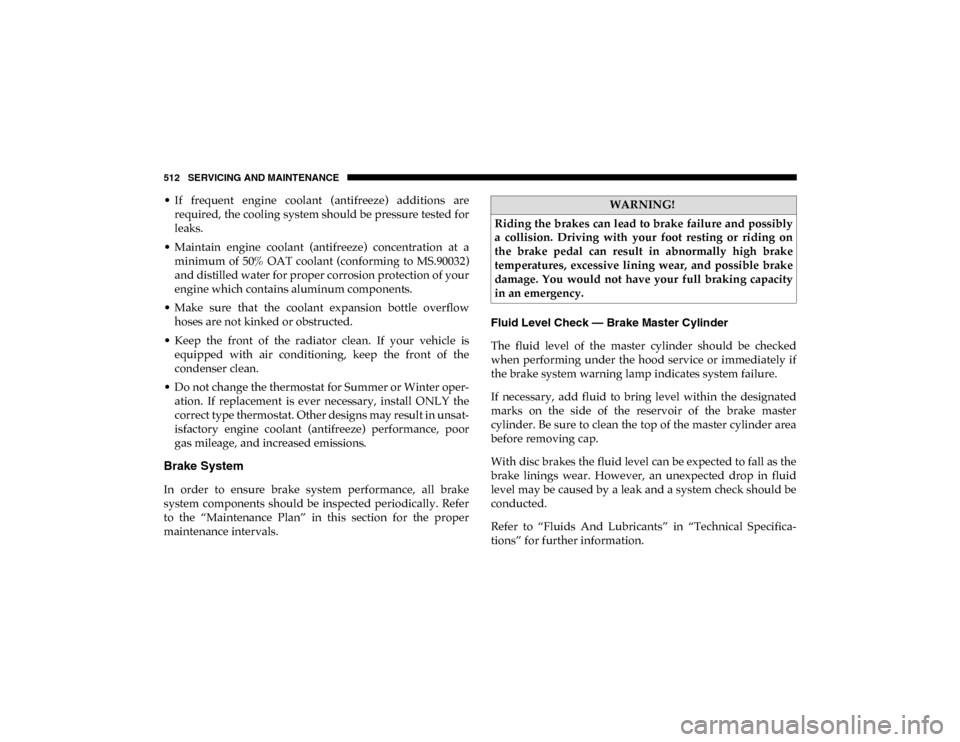
512 SERVICING AND MAINTENANCE
• If frequent engine coolant (antifreeze) additions arerequired, the cooling system should be pressure tested for
leaks.
• Maintain engine coolant (antifreeze) concentration at a minimum of 50% OAT coolant (conforming to MS.90032)
and distilled water for proper corrosion protection of your
engine which contains aluminum components.
• Make sure that the coolant expansion bottle overflow hoses are not kinked or obstructed.
• Keep the front of the radiator clean. If your vehicle is equipped with air conditioning, keep the front of the
condenser clean.
• Do not change the thermostat for Summer or Winter oper -
ation. If replacement is ever necessary, install ONLY the
correct type thermostat. Other designs may result in unsat -
isfactory engine coolant (antifreeze) performance, poor
gas mileage, and increased emissions.
Brake System
In order to ensure brake system performance, all brake
system components should be inspected periodically. Refer
to the “Maintenance Plan” in this section for the proper
maintenance intervals. Fluid Level Check — Brake Master Cylinder
The fluid level of the master cylinder should be checked
when performing under the hood service or immediately if
the brake system warning lamp indicates system failure.
If necessary, add fluid to bring level within the designated
marks on the side of the reservoir of the brake master
cylinder. Be sure to clean the top of the master cylinder area
before removing cap.
With disc brakes the fluid level can be expected to fall as the
brake linings wear. However, an unexpected drop in fluid
level may be caused by a leak and a system check should be
conducted.
Refer to “Fluids And Lubricants” in “Technical Specifica
-
tions” for further information.
WARNING!
Riding the brakes can lead to brake failure and possibly
a collision. Driving with your foot resting or riding on
the brake pedal can result in abnormally high brake
temperatures, excessive lining wear, and possible brake
damage. You would not have your full braking capacity
in an emergency.
2020_DT_1500_OM_US.book Page 512
Page 555 of 674
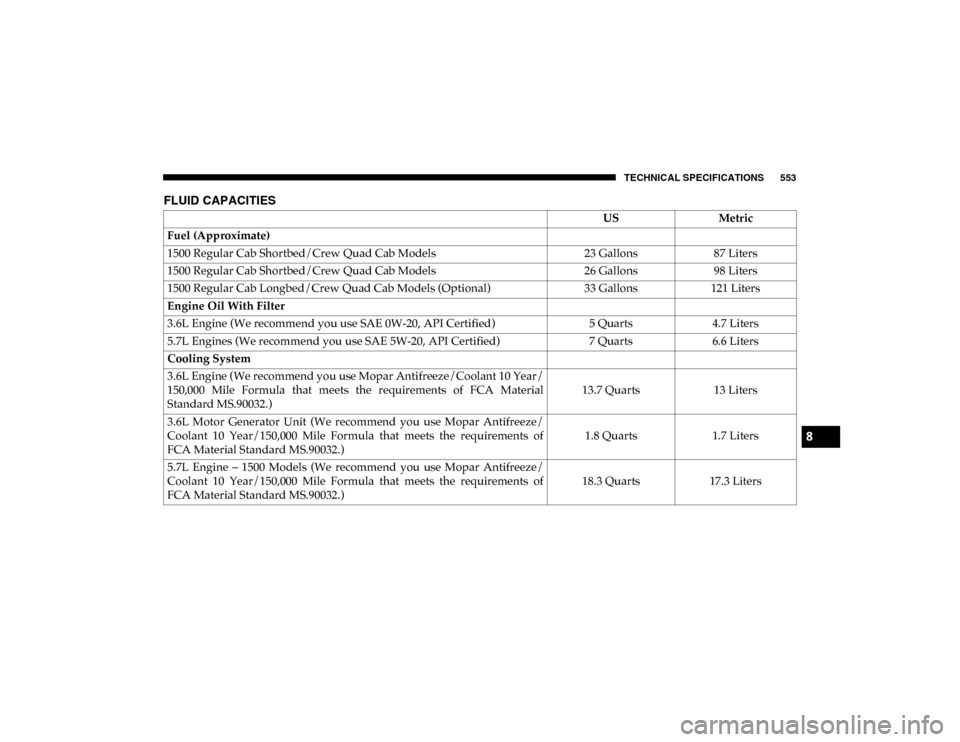
TECHNICAL SPECIFICATIONS 553
FLUID CAPACITIES
USMetric
Fuel (Approximate)
1500 Regular Cab Shortbed/Crew Quad Cab Models 23 Gallons87 Liters
1500 Regular Cab Shortbed/Crew Quad Cab Models 26 Gallons98 Liters
1500 Regular Cab Longbed/Crew Quad Cab Models (Optional) 33 Gallons121 Liters
Engine Oil With Filter
3.6L Engine (We recommend you use SAE 0W-20, API Certified) 5 Quarts4.7 Liters
5.7L Engines (We recommend you use SAE 5W-20, API Certified) 7 Quarts6.6 Liters
Cooling System
3.6L Engine (We recommend you use Mopar Antifreeze/Coolant 10 Year/
150,000 Mile Formula that meets the requirements of FCA Material
Standard MS.90032.) 13.7 Quarts
13 Liters
3.6L Motor Generator Unit (We recommend you use Mopar Antifreeze/
Coolant 10 Year/150,000 Mile Formula that meets the requirements of
FCA Material Standard MS.90032.) 1.8 Quarts
1.7 Liters
5.7L Engine – 1500 Models (We recommend you use Mopar Antifreeze/
Coolant 10 Year/150,000 Mile Formula that meets the requirements of
FCA Material Standard MS.90032.) 18.3 Quarts
17.3 Liters
8
2020_DT_1500_OM_US.book Page 553
Page 556 of 674

554 TECHNICAL SPECIFICATIONS
FLUIDS AND LUBRICANTS
Engine
ComponentFluid, Lubricant, or Genuine Part
Engine Coolant
We recommend you use Mopar Antifreeze/Coolant 10 Year/
150,000 Mile Formula OAT (Organic Additive Technology).
Motor Generator Unit (If Equipped)
We recommend you use Mopar Antifreeze/Coolant 10 Year/
150,000 Mile Formula OAT (Organic Additive Technology).
Engine Oil – 3.6L Engine We recommend you use API Certified SAE 0W-20 Engine
Oil, meeting the requirements of FCA Material Standard
MS-6395 such as Mopar, Pennzoil, and Shell Helix. Refer to
your engine oil filler cap for correct SAE grade.
Engine Oil – 5.7L Engine We recommend you use API Certified SAE 5W-20 Engine
Oil, meeting the requirements of FCA Material Standard
MS-6395 such as Mopar, Pennzoil, and Shell Helix. Refer to
your engine oil filler cap for correct SAE grade.
Engine Oil Filter We recommend you use Mopar brand Engine Oil Filters.
Spark Plugs We recommend you use Mopar Spark Plugs.
Fuel Selection – 3.6L Engine 87 Octane (R+M)/2 Method, 0-15% Ethanol (Do not use
E-85).
Fuel Selection – 5.7L Engines 89 Octane Recommended - 87 Octane Acceptable (R+M)/
2 Me thod, 0-15% Ethanol (Do not use E-85).
2020_DT_1500_OM_US.book Page 554